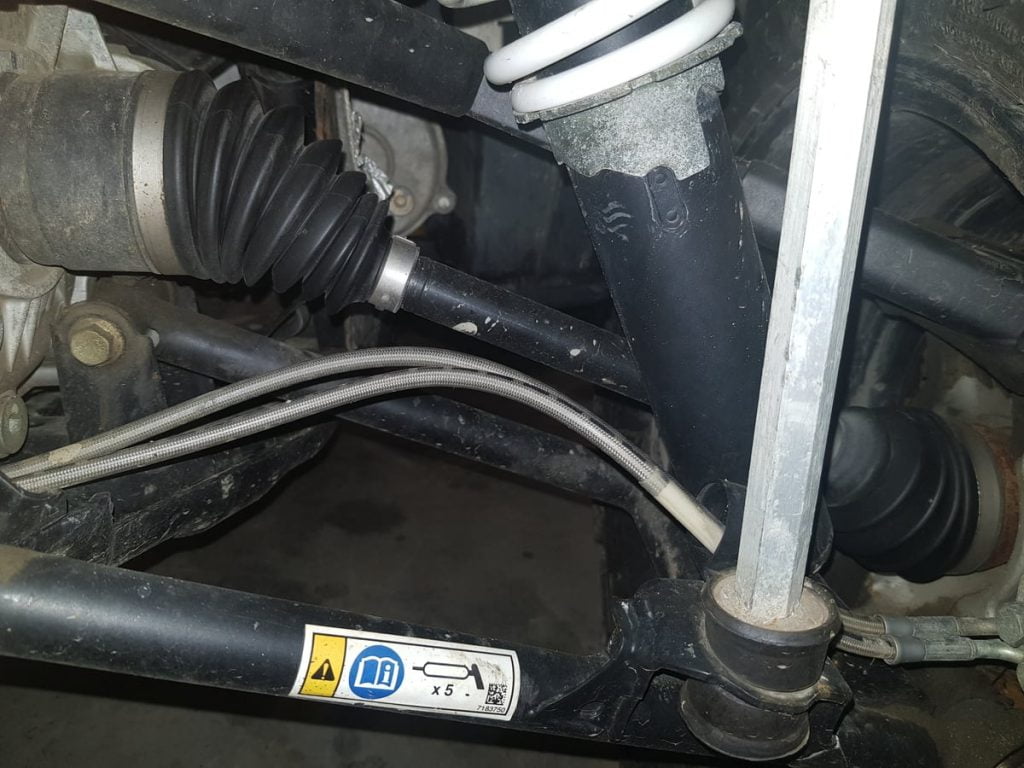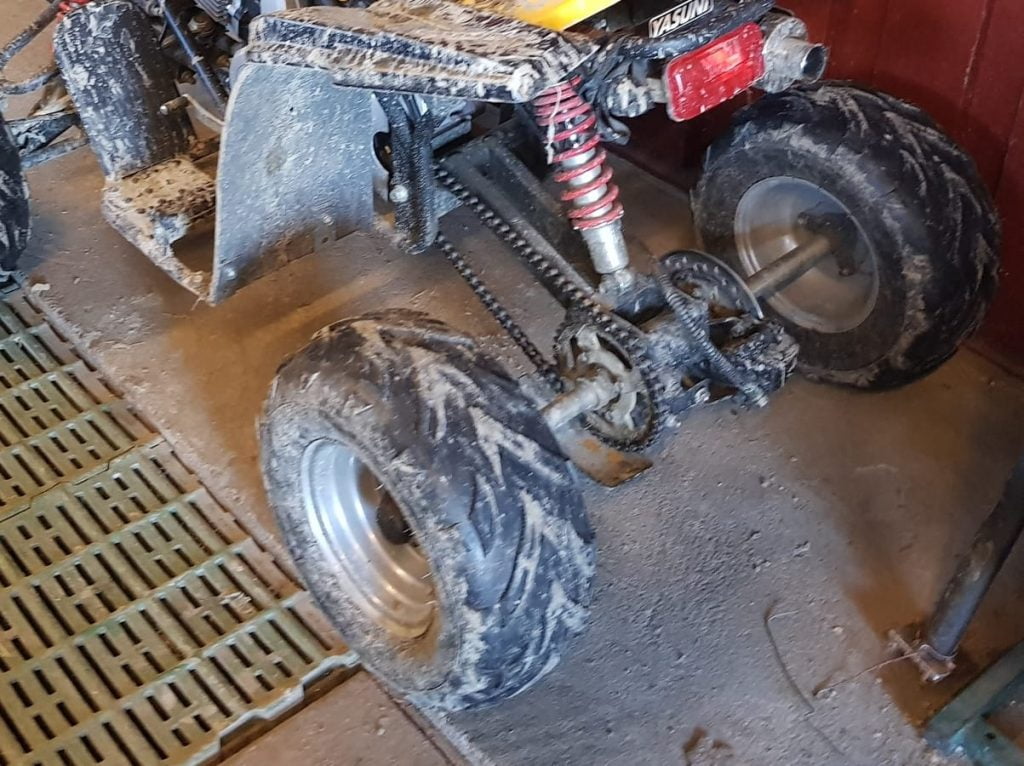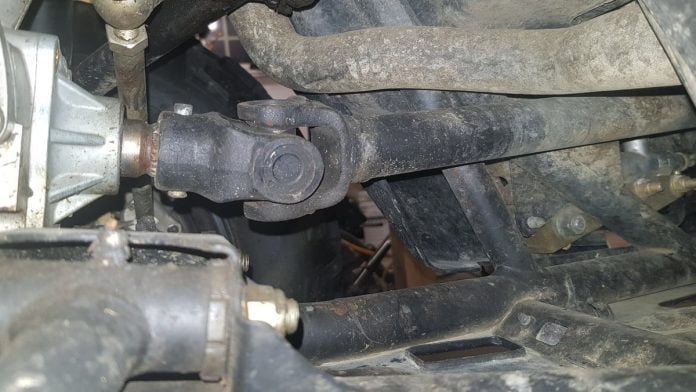Many factors must be considered when you’re in the market for a new ATV, including what drive system you should choose. You may have heard about belt, shaft, and chain-driven ATVs. You will learn that these terms are often used interchangeably, causing unnecessary confusion.
That’s why I decided to make this post to help clarify some of the terminologies and provide an overview of which shaft-driven ATVs are on the market.
Most utility and recreational ATVs on the market are shaft-drive; they use metal drive shafts to transfer power from the transmission to the wheels. This includes both ATVs with a belt-driven CVT transmission and beltless alternatives offered by Honda. The exception is most sports quads and some youth ATVs that are chain drive.
The Three Different ATV Drive Designs
To understand why most ATVs are considered shaft driven, we need to clarify what we mean when discussing an ATV being shaft drive, belt drive, or chain drive.
These three different terms refer to what style of drivetrain a vehicle has. But the terms are not always used the same way with all types of vehicles. Also, They do not always refer to the same specific drivetrain component.
The drivetrain includes every component that transfers the engine’s power to the wheels, including the transmission. Different setups have different groups of components.
The driveline includes every component that transfers the power from the engine to the wheels, except the transmission.
The ATVs in the market today come with one of two main styles of transmission systems:
- CVT, continuously variable transmission. A CVT can be belt-driven, but this does not make the ATV belt drive. A CVT can also be chain driven (not so common on ATVs), but this does not make the ATV chain drive.
- Geared transmission. A geared transmission is assembled using metal gears and shafts, but this does not make the ATV shaft drive. Mechanical gearbox transmissions on ATVs are either manual, semi-automatic or fully automatic.
Here is an overview of ATVs that have automatic transmissions.
Honda used to offer a hydrostatic transmission with their Hondamatic models, but none of their current models offer this transmission style. They do, however, use hydraulic torque converters.
What Is Shaft-Drive on an ATV?
Shaft drive on an ATV usually refers to the driveline style and not the transmission’s inner workings. Regardless of an ATV’s transmission type, it may still be a shaft drive.
The shafts in a shaft drive refer to the metal driveshafts and axles that transfer power from the transmission to the wheels via the front and rear differentials.

Some people refer to ATVs with non-belt transmissions, usually those featuring a gearbox and clutch setup, as “shaft-drive.” While their reference may be accurate, it’s not because of the presence of a gearbox. Instead, the designation of “shaft drive” stems from using driveshafts and axles in the ATV’s configuration.
If a beltless ATV with a gearbox and clutch use a chain to drive the wheels, it is chain drive, not shaft drive.
Despite a gearbox being made from metal gears and shafts, it isn’t classified as a shaft drive. So even if an ATV has a gearbox, the driveshafts and axles are what ultimately qualify it as a shaft drive vehicle.
Referring to beltless ATVs as a shaft drive may confuse since ATVs with CVT belt transmissions are shaft drives as well.
Let’s compare a few examples:
A Can-Am Outlander has a CVT transmission and uses metal driveshafts and axles to transfer the power to the wheels. It is a shaft-drive ATV with a belt-drive transmission.
A Honda Fourtrax Foreman ES has a five-speed + reverse automatic transmission and direct front and rear driveshafts. It’s a shaft-drive ATV with an automatic gearbox.
A Yamaha Raptor 700 has a five-speed + reverse transmission with a chain final drive. It’s a chain-drive ATV with a manual gearbox.
What Is Belt Drive on an ATV?
Belt drive on an ATV usually refers to a belt-driven CVT transmission style.

Most belt-driven ATVs are also shaft drive since they use metal shafts and axles to transfer the power from the CVT transmission to the wheels.

Confusion occurs when comparing ATV belt drive with motorcycle belt drive as they differ.
Some motorcycle manufacturers, such as Harley Davidson, offer a few models where the metal chain final drive is replaced with a rubber belt. This makes the driveline classify as a belt drive. ATVs, however, do not use belts in their driveline, only in the CVT transmission.
What Is Chain Drive on an ATV?
Chain drive on an ATV usually refers to the metal chain that transfers power from the transmission to the rear axle. Using a metal chain, one sprocket on the gearbox is connected to another sprocket on the rear axle.

This setup is available on most sports quads and some youth ATVs.
Technically, a gearbox contains a metal chain, but most people don’t consider them chain drive regardless.
What ATVs Are Shaft-Driven?
All ATVs that use metal driveshafts and axles to transfer the power from the transmission and out to the wheels are shaft drives. This includes ATVs with belt-driven CVT transmissions and ATVs with a gearbox and clutch transmission setup.
Here is a list of ATVs that are shaft-drive:
Brand and model | Transmission type | Driveline |
Can-Am Outlander series | CVT belt-drive | Shaft and axle drive |
Can-Am Renegade series | CVT belt-drive | Shaft and axle drive |
Polaris Sporsman Series* | CVT belt-drive | Shaft and axle drive |
Polaris Scrambler Series | CVT belt-drive | Shaft and axle drive |
Polaris ACE series* | CVT belt-drive | Shaft and axle drive |
Yamaha Kodiak series | CVT belt-drive | Shaft and axle drive |
Yamaha Grizzly series | CVT belt-drive | Shaft and axle drive |
Honda Fourtrax Rincon | Geared transmission | Shaft and axle drive |
Honda Fourtrax Foreman series | Geared transmission | Shaft and axle drive |
Honda Fourtrax Rancher | Geared transmission | Shaft and axle drive |
Kawasaki Brute Force series | CVT belt-drive | Shaft and axle drive |
What ATVs are not shaft-driven?
ATVs that use a metal chain instead of metal shafts to transfer power from the gearbox to the wheels are chain drive, not shaft drive.
Here is a list of ATVs that are not shaft-drive:
Brand and model | Transmission type | Driveline |
Can-Am DS series (youth) | CVT belt-drive | Chain-drive |
Polaris Outlaw series (youth) | CVT belt-drive | Chain-drive |
Polaris Sportsman 110 (youth) | CVT belt-drive | Chain-drive |
Polaris ACE 150 EFI (youth) | CVT belt-drive | Chain-drive |
Yamaha YFZ 50 (Youth) | CVT belt-drive | Chain-drive |
Yamaha YFX 450 | Geared transmission | Chain-drive |
Yamaha Raptor series | Geared transmission | Chain-drive |
Kawasaki KFX series (youth) | CVT belt-drive | Chain-drive |
Shaft-Drive vs. Others Chain-Drive on ATVs
All drive systems come with their share of pros and cons.
Effectivity and Weight
Chain-drive systems weigh significantly less than shaft-drive systems. This makes them the preferred alternative in most racing applications, where weight saving is crucial.
Also, you get more engine power to the wheels with chain-drive over shaft drive. Depending on its design, a shaft drive system can bleed as much as 10-20% of engine power due to all joints and moving gears. Chain and sprocket-based systems have a modest 1-4% transmission power loss.
Racing quads need every horsepower to the wheels to win the race, which leaves chain and sprocket the preferred alternative.
Cost
The main advantage of a chain-drive system is a significantly lower initial cost due to its simple design. In addition to weight savings, this is why many youth models come with chain drives.
Reliability and Maintenance
Shaft-drive is considered more reliable in the long run than chain-drive. This is primarily due to a more straightforward maintenance schedule.
The chain and sprockets in a chain-dive system wear down over time and eventually must be replaced. Replacing the sprockets and chain is something most home mechanics can perform on their own, but the parts’ cost adds up over time.
Regular maintenance with cleaning and relubricating is required to ensure longevity.
The replacement interval depends on how hard and in what condition the quad is ridden. Racers must replace the chain and sprockets far more often than the casual recreational rider.
Driveshaft systems are not maintenance-free but require far less maintenance than a chain drive.
Some ATVs have u-joints that need to be greased occasionally, and you need to replace the oil in the diffs at given intervals.
Driveshafts do not wear as a chain does. You may need to replace parts such as u-joints or CV axles every other year, but that’s about it. A shaft
Off-Road Capabilities
The chain and sprocket are exposed underneath the bike, leaving them vulnerable to impact damage or jammed debris when taking a chain-drive ATV off-road.
Shaft-drive offers better ground clearance and can take more of a beating without causing issues.
Why Some ATVs Use Belt Drives, and Others Use Gears
Reliability
Geared transmissions with an auto or manual clutch are generally considered more reliable than a belt-driven CVT transmission.
If a CVT belt overheats or is pushed too hard, it may shatter into a million tiny pieces, leaving you stranded on the trail. Big mud wheels or tracks are notorious for destroying belts. A CVT transmission can be upgraded using a clutch kit to make it more likely to handle big wheels, but it still has limitations.
If a CVT belt gets wet for some reason, it cannot drive the ATV forward. If you push too hard before the belt dries, it may start slipping, ruining the belt.
While you could replace a broken CVT belt on the trail, it usually requires more work than replacing one on a snowmobile. You would also need to bring a spare belt at all times.
Cost
CVT belt transmissions are considered more straightforward and cheaper to manufacture than geared transmissions.
This is likely why most ATVs come with this transmission style in today’s market.
Maintenance
A geared transmission requires the occasional oil change. Other than that, it’s mainly considered maintenance-free.
CVT transmissions require slightly more maintenance to operate reliably.
The rubber drive belt wears out over time and needs to be replaced. The replacement interval varies depending on factors such as how much power the ATV has, if you pull heavy loads, or if you run oversized wheels.
A CVT belt replacement costs about $50 to $100 plus labor if you don’t want to do the job yourself.
The CVT clutches may get dirty over time, causing belt slipping and other issues. Expect having to clean the clutches every other year.
During the lifespan of an ATV, you may also run into issues such as belt deflection needing adjustment and clutches coming you of alignment. A mechanic usually performs these types of adjustments.
Related Questions
Are All ATVs Belt Driven?
Most ATVs in today’s market use a belt-driven CVT transmission but do not use a belt to transfer the power from the gearbox out to the wheels. They use a chain, shaft, or axle driveline to achieve this. The ATVs that don’t use a belt-driven CVT transmission use a manual, semi-automatic, or manual gearbox with gears and clutches.
How does a shaft drive compare to a chain drive on an ATV?
Shaft drives are generally more durable, quieter, and require less maintenance than chain drives, but they may add weight and cost to the ATV.
Is it hard to maintain an ATV shaft drive?
Shaft drives are relatively low maintenance. Regular checks, lubrication, and keeping the system clean should keep it in good working order.
Can I upgrade my ATV from chain drive to shaft drive?
Upgrading from chain to shaft drive is a complex task that often isn’t practical due to design differences and cost implications.
Wrapping Up
Navigating the market for a new ATV can be overwhelming with the multitude of drive systems available.
This article has attempted to alleviate some of this confusion, breaking down the complex terminologies and outlining the different types of drive systems you might encounter in your search.
We hope you are now more prepared to make an informed decision about your next ATV purchase.

